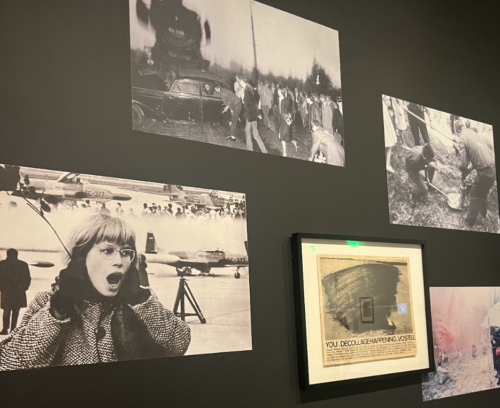A loaf of bread, strobe lights, and a hunk of concrete—not every museum exhibit can claim to contain all these objects in one room. But the Harvard Art Museums’ new show, “Wolf Vostell: Dé-coll/age Is Your Life,” can, and does.
The exhibition chronologically leads viewers through the development of the work of German artist Wolf Vostell (1932–1998) throughout his lifetime. The exhibition was born from the Harvard Art Museums’ recent large acquisition of 72 works by Vostell, including “prints, multiples, audiovisual works, sculptures, and performance ephemera.” The primary focus of the exhibition is Vostell’s aesthetic philosophy of dé-coll/age, which the exhibition defines as “the use of destruction in art to generate consciousness of destruction in life.” The French word “décollage” literally means “to unstick.” In 1963, Vostell “appropriated the term,” stylizing it as “dé-coll/age,” to represent his personal aesthetic philosophy.
The Harvard Art Museums’ exhibition seeks to understand Vostell’s dé-coll/age in the current moment through an archeological project, one that catalogs his work and serves as a reminder of past global histories of genocide as well as the world’s complacency when faced with mass violence. Vostell and his family were exiled from their home in Germany during the Second World War, so his firsthand experience with mass destruction changed the course of his life. Curator Kyle Stephan described Vostell’s early experience with such violence as the “impetus for much of his artistic production.”
Vostell is perhaps most well-known for his use of “assisted readymades,” the alteration of everyday objects into works of art. Vostell began by combining pieces of peeling street posters leftover on Germany’s street walls, tearing at the layers until he unearthed National Socialist propaganda from World War II. These works specifically comment on the insidious nature of genocide and the Holocaust.
Vostell sought to apply his “subtractive process,” as Stephan described it, of dé-coll/age to non-traditional mediums other than street posters throughout the 20th century. His work, situated in the larger Fluxus movement of the mid 20th-century, sought to “communicate a social reality beyond the studio,” said Stephan. The movement consisted of a community of artists, writers, and performers and was known for multimedia work that pushed the boundaries of what society considered to be art, like its interactive art pieces called “happenings.”
Vostell used these Fluxus mediums of interactive performance art to convey social messages. In particular, he sought to raise awareness of contemporary occurrences of mass violence throughout his life, such as the Vietnam War. As Stephan said, Vostell’s experimentation with new mediums culminated in the “televisual environment becoming dominant” in his work. Vostell was the first artist to integrate a television into a work of art (Transmigration, 1958).
Eventually, Vostell moved to using concrete, representing a shift during his career towards more permanent and hard mediums. Think Marcel Duchamp’s famous Fountain, but if the urinal was buried in concrete. And replace the urinal with a radio. The Harvard Art Museums’ show reflects this important phase of his career with its display of Endogene Depression V, a radio encased in concrete, as the final work of the exhibition.
As Stephan drew the exhibition tour to a close, she emphasized that during the 20th century, Vostell continued to chase after the newest way to apply dé-coll/age to the contemporary world. “He was always thinking, ‘What is the leading medium of our time and how can I apply dé-coll/age to that?’” He was constantly pioneering methods to incorporate deconstruction and commentary on violence into visual and audiovisual media. The exhibition uniquely engages with the wide variety of mediums that Vostell interacted with during his career, spanning from street posters to television to concrete, in a way that highlights the relevance of his work in our present moment.
“Wolf Vostell: Dé-coll/age Is Your Life” is on view in the University Research Gallery of the Harvard Art Museums from January 20th, 2024 through May 5th, 2024.
Sachi Laumas ’26 (slaumas@college.harvard.edu) can usually be found in the Harvard Art Museums’ café.

